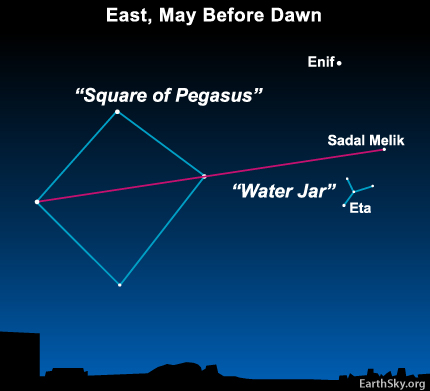Courtesy of EarthSky
A Clear Voice for Science
www.EarthSky.org

 The Eta Aquarid meteor shower is now taking stage in the dark hours before dawn. It has expected to peak in the predawn sky on Thursday morning – May 6, 2010 – from roughly two hours to one hour before sunrise. Look on our almanac page for your sunrise time. Under ideal conditions, this shower can produce up to 20 to 40 meteors per hour. However, in 2010, the last quarter moon will wash out all but the brighter meteors of this annual shower.
The Eta Aquarid meteor shower is now taking stage in the dark hours before dawn. It has expected to peak in the predawn sky on Thursday morning – May 6, 2010 – from roughly two hours to one hour before sunrise. Look on our almanac page for your sunrise time. Under ideal conditions, this shower can produce up to 20 to 40 meteors per hour. However, in 2010, the last quarter moon will wash out all but the brighter meteors of this annual shower.
The point in the sky from which meteors in annual showers appear to radiate is called the meteor shower radiant. You do not have to locate the radiant to watch the Eta Aquarid meteors, but people always ask about them. Although the Eta Aquarid meteors streak all over the sky, they appear to radiate from the Y-shaped group of stars called the Water Jar. The Water Jar is part of the constellation Aquarius.
To star-hop to the Water Jar, first of all find the four stars of the Great Square of Pegasus. Looking eastward at about 4 to 4:30 a.m. (Daylight Saving Time), the Great Square of Pegasus glitters like a celestial baseball diamond. Imagine the bottom star as home base. Draw a line from the third base star through the first base star, then go twice that distance to locate the star Sadal Melik.
To the lower left of Sadal Melik is the small Y-shaped Water Jar, marking the approximate radiant of the Eta Aquarid meteor shower. Again, you don’t need to know the shower’s radiant point to watch the meteors! During the wee morning hours before dawn, the meteors in this annual shower will appear in all parts of the sky.
Related:
EarthSky’s meteor shower guide for 2010
Why does the Eta Aquarid shower favor the southern hemisphere?
Written by Bruce McClure
Astronomy Picture of the Day from NASA/JPL
U.S. Naval Observator Astronomical Information center
The York County Astronomical Society
 Print This Post
Print This Post








